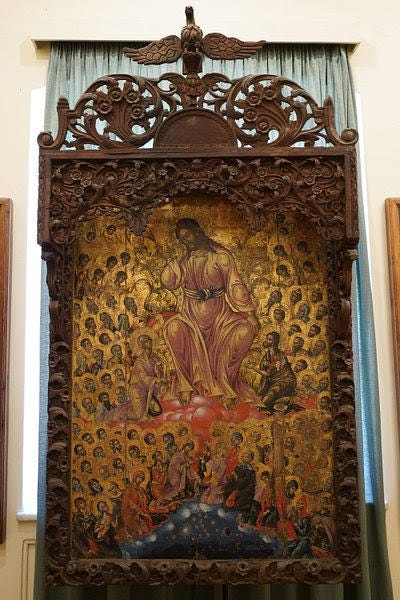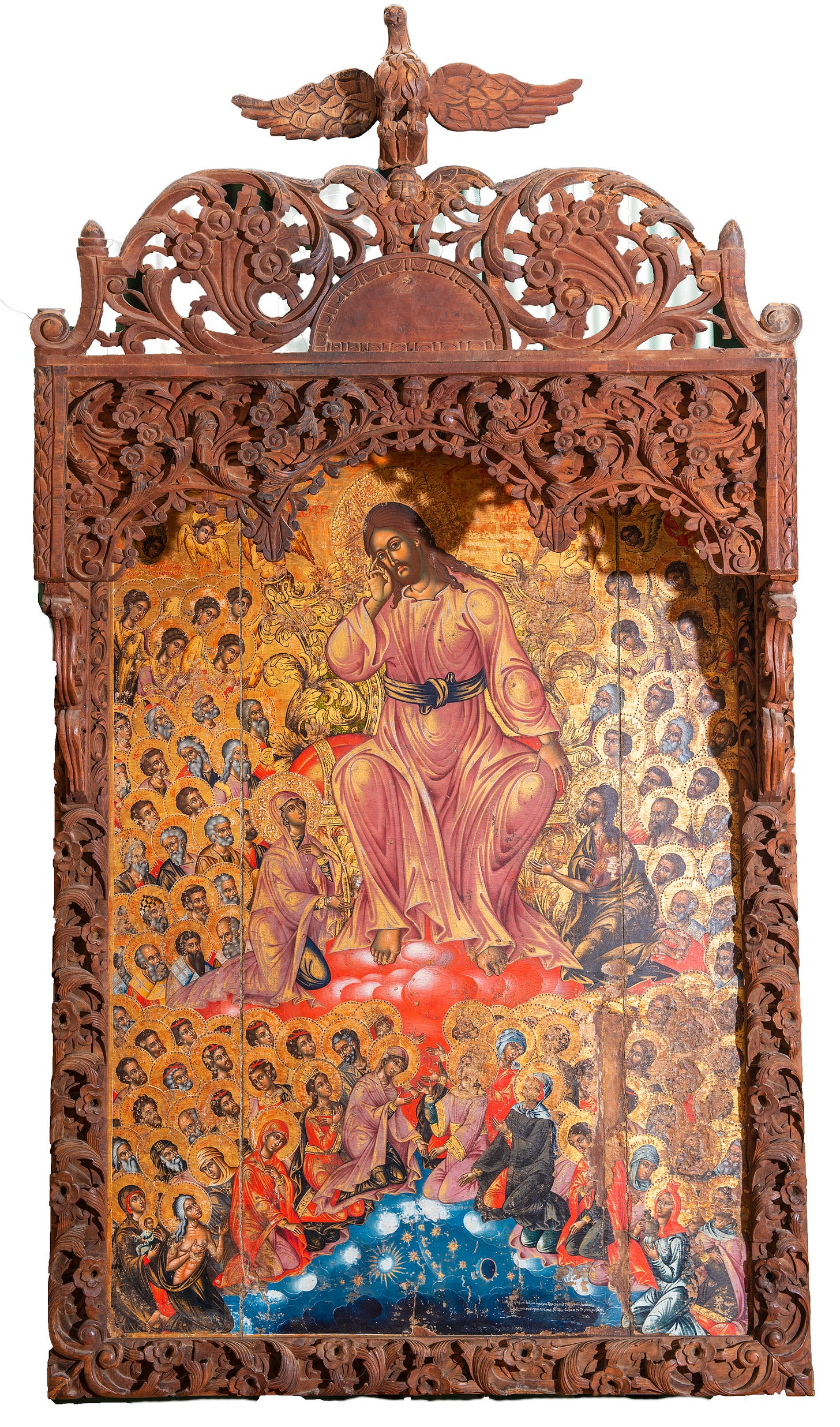Christ the Judge
A hi-res image of an 18th century Byzantine icon yields surprising details.
In April of this year,
reached out to his readers for assistance. In a short but touching essay, he introduced us to a work of art called Christ the Judge, and his search for a proper reproduction to replace his aging postcard version.Crafted by Ioannis Athanasiou in 1773, the icon depicts Christ seated upon his throne in Heaven, surrounded by souls awaiting his decision. He wears a look of contemplation and discernment, and perhaps a touch of the weary reluctance Dr. McGilchrist notes in his article’s title. He is not the wrathful hanging judge, eager to impose his authority to punish. He judges because he must, because he is uniquely suited by his two-willed nature to understand and forgive. And he is looking straight at me, across impossible distances of space and time. I know I am not worthy, but I also know I can be healed with a word.
Here is the postcard version as photographed by Caro Ross.
As you’ll soon see, this print medium isn’t exactly conducive to capturing or maintaining finer details, and there appears to be significant loss of color grading and contrast. While I have not seen the piece with the naked eye, I presume that Ross did the best she could with the material and post-production methods available.
For comparison, here is a promotional photo of the piece taken in the Byzantine Museum of Ioannina, where it has resided since its acquisition from the Zosimaia Academy collection at some point after the museum’s opening in 1995. In addition to the elaborate baroque frame, note how the gilded paint illuminates both the faces of the petitioners and Christ himself. We can also see a glimpse of the fuller color palette, including a red globular surface that Christ’s feet rest upon and the patch of blue cosmos beyond the Veil. Or is it a symbol of the Veil itself?
This compressed photo was the highest resolution I could find through normal search methods. And, as Dr. McGilchrist noted, it led me back to the same museum that he contacted for help in obtaining a high quality reproduction. I decided to reach out to the museum in a separate request, composed in (my admittedly clumsy and amateurish version of) Greek.
Several weeks went by, and I was beginning to wonder if it had fallen on deaf ears, or been lost in some digital version of a Dead Letter Office. One of the quiet spiritual perils in our age of global networks is that our expectation of high speed transactions distorts our perception of reality, and makes us absurdly impatient. How long did it take Athanasiou to make it? How many lifetimes of reverent care did it require to preserve it, so that we could even gaze upon a digital echo of its beauty?
So I managed to banish these thoughts from my mind and redoubled my faith. Then, lo and behold, less than 24 hours after commenting about my efforts on Iain’s blog, an archaeologist from the Ministry of Culture reached back, and sent me the following image file.
Unfortunately, Substack applies its own WebP compression to uploaded images, so even the picture shown above is not the same as the high quality file I was sent. But even in this lower quality format, you might notice evidence of faint inscriptions in the halos of the souls, implying the artist’s intimate knowledge and purposeful choice of his individual subjects. We see faces and costumes from East and West, North and South. Some look not at the judge but rather at us, aware of our presence. The result is not an undifferentiated mass of clones, which would be easy to judge in terms of quality. Instead we encounter a range of distinct, created beings with unique experiences and paths through Earthly life, requiring a kind of discernment that is both human and surpassingly Divine.
When viewed at the resolution of 2086 x 3643 (300 DPI), these and other rich details spring to vivid life. Having worked professionally in related fields, I can see this file was obviously the end result of a loving, painstaking and devoted post production effort. While I would prefer an even larger format (if not the uncompressed RAW file), I trust that this is the highest quality file the Ministry of Culture has approved for public release, and I think this is suitable for reproduction in a variety of physical formats, even without strategic upscaling.
My wife and I plan on exploring several options for display in our own home. I may need to preform some additional post production to remove the frame’s shadow, and perhaps perform some edge reconstruction for covered-up portions of the upper corners. If and when we make progress in this project, I will be sure to update you all with our methods and results.
That said, a photograph is only a shadow, no matter how well resolved. In this form, I am reminded again of the physical connection we are allotted in museums and galleries, to see with our own eyes. But then again, even our eyes are imperfect cameras, showing us only a small slice of what is real and true.
I have attempted to contact Iain with this happy news by comment and by replying to the emailed article, but to no avail. If any of my readers know him personally or are in regular online communication, I ask that you please bring this item to his attention, so that I can transmit the high resolution JPG file to him directly or via a public share.
I extend the same offer to the rest of you, by the way. If you would like me to send you the file, please let me know via email reply to this post, as that would be the fastest and easiest way. Otherise, you can privately message me on Substack with an email address where i can send it to you. All I ask in return is that you leave a like (and, even better, a short comment) on this post. If you cannot afford to support my work monetarily, that’s a good way to support it algorithmically and even spiritually. It helps fuel my drive to keep writing.
I am also tagging
of the , as I believe she would be interested in this incredible work of art, and perhaps could shed more light on its creation and significance for the rest of us.Note: If you are currently in a position to make a small contribution, you will have my utmost gratitude for doing so. I rarely paywall my Substack content, but the focus I can afford to give to my writing is severely limited by the pressure of having to provide for my family with “real” work. I essentially lose money every time I pick up the pen, so my goal in gaining paid subscribers isn’t so much profit as it is controlling losses and opportunity costs.
I won’t ask for an ongoing commitment (we often make too many of those). But even a single month’s subscription would help us tremendously. Cancel any time!
If you can’t swing a subscription, you might instead consider making a donation at my tip jar site, buymeacoffee.com. Minimum donation is $5 USD, but it will give you access to some select paywalled content.







Just a reminder: If you want the Ministry of Culture's hi-res version, please respond to the email version of this post. If you don't receive emails (i.e. you have that option switched off) contact me via Substack Message with the request and an email where I can send it. And don't forget to click the "like" button! Every little bit helps.
Yes, please, Mr. Bisone, I would love this image.